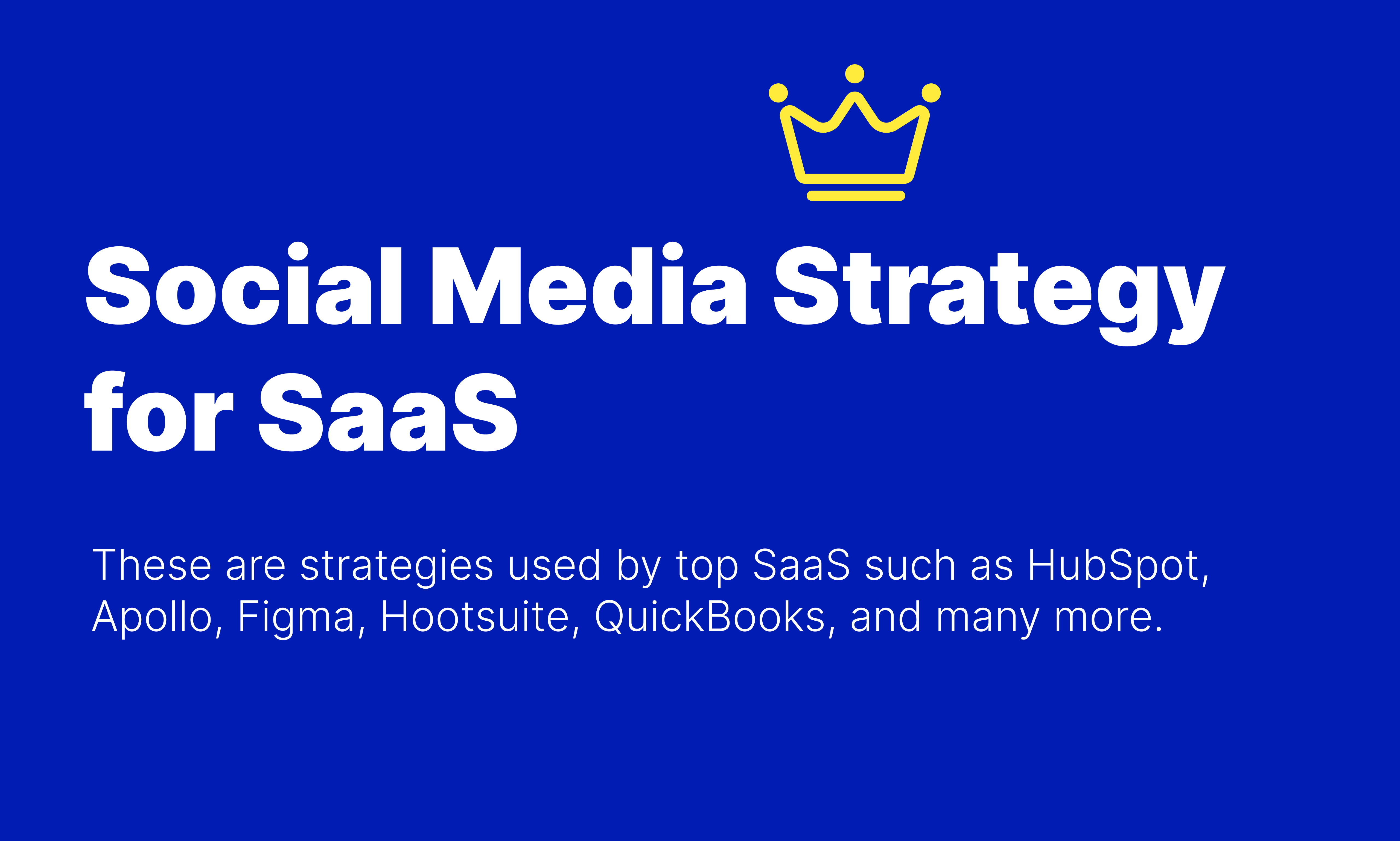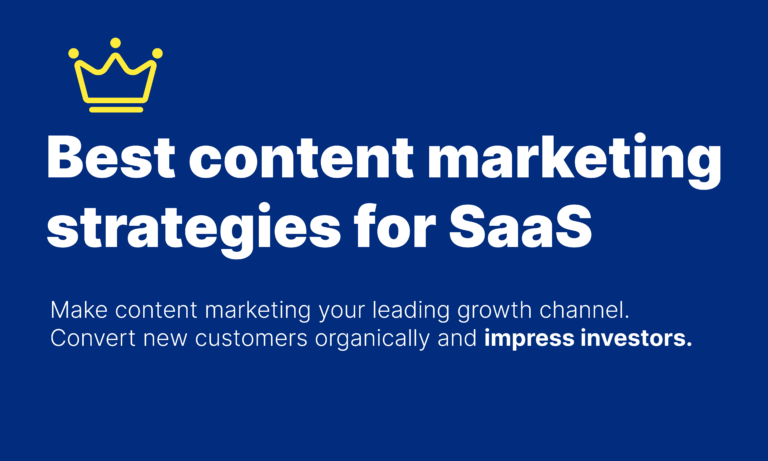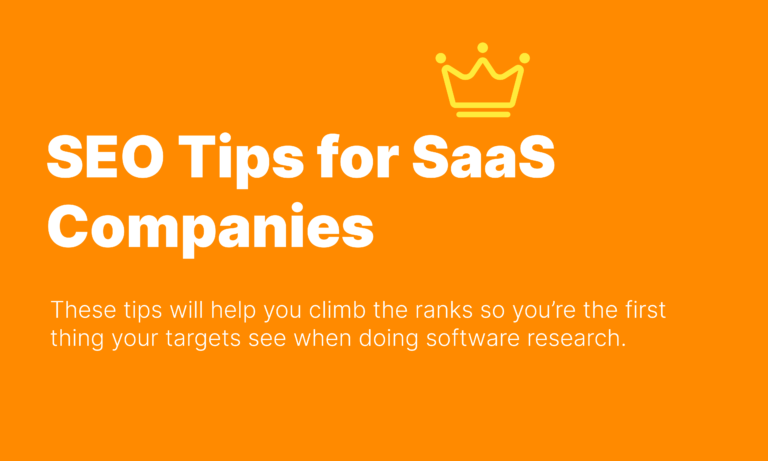Social Media Strategy for SaaS: How The Best Do It

SaaS social media strategies are very straightforward.
You can start following the strategies in this guide, based on the most effective SaaS companies out there.
These are strategies used by top SaaS such as HubSpot, Apollo, Figma, Hootsuite, QuickBooks, and many more.
Does Your SaaS Need a Social Media Strategy?
Let’s look at the data.
- Approximately three-quarters of consumers make purchases based on discoveries they make on social platforms.
- Social media advertising campaigns, on average, yield a 250% return on investment
- Nearly all B2B marketers incorporate social media content into their broader content marketing plans.
- Three-quarters of internet users utilize social media platforms to research products.
All of this means that you need to be on social media if you want to capture as many buyers as possible.

We can do your content marketing
Uphill Content specializes in growing SaaS businesses, from early-stage to exit. Send us a message to learn how we can help.
How Are Social Media Strategies for SaaS Different?
SaaS social media strategies differ notably from other businesses due to their focus on long-term engagement rather than immediate sales.
Unlike tangible products, SaaS offerings require an emphasis on educating potential customers about the software’s features, benefits, and applications.
This involves nurturing leads over a longer sales cycle, building trust through sharing expertise, customer success stories, and transparent communication.
Additionally, SaaS companies prioritize community building and continuous customer engagement post-purchase to ensure customer satisfaction and retention, a contrast to product-based businesses where the focus might be more on showcasing the product’s immediate appeal and functionalities.
Identifying Your Target Audience
Successfully identifying your target audience is a pivotal step in crafting a social media strategy that resonates and drives results.
For SaaS companies, this means understanding who will benefit most from your software and where these potential users engage online. Here are key points to consider:
Business Decision Makers: Often the primary audience for B2B SaaS products, these include executives, managers, and team leaders who seek efficient solutions to improve their operations.
IT Professionals: This group is critical for technical SaaS offerings. They look for products that offer reliability, security, and integration capabilities.
End-Users: Understanding the needs and preferences of the actual users of your SaaS product can guide your content and engagement strategies.
Industry-Specific Audiences: If your SaaS product caters to specific industries (like healthcare, education, or finance), tailor your audience identification accordingly.
Geographic and Demographic Segmentation: Depending on your service, consider if your audience is global or local, and what demographic factors (such as age, job role, or company size) influence their software choices.
Current Customer Analysis: Analyze your existing customer base to find common characteristics and preferences. This can inform not only who your audience is but also how to effectively engage them.
Engagement on Social Platforms: Look at where your potential audience is most active. LinkedIn might be more suitable for professional and B2B engagement, while Instagram or Twitter could be better for reaching a broader, more diverse user base.
Competitor Analysis: Observe how similar SaaS providers engage their audience. This can offer insights into audience preferences and gaps in your competitors’ strategies that you could fill.

Get a free SEO audit
Enter your business email below to get a free SEO audit with actionable insights to improve your site.
Selecting the Right Social Media Platforms
Choosing the right social media platforms is crucial for effectively reaching and engaging with your intended audience.
Each platform has its unique characteristics and user demographics, making some more suitable than others for different SaaS models, whether B2B or B2C.
Audience: Primarily professionals across various industries.
Best For: B2B SaaS companies. It’s ideal for networking, establishing thought leadership, and targeting decision-makers through tailored content and LinkedIn Ads.
Audience: Broad, ranging from young adults to professionals, known for real-time content.
Best For: Both B2B and B2C SaaS. Great for quick updates, customer service, engaging with trends, and participating in industry conversations.
Audience: Diverse, with a significant number of users across different age groups.
Best For: More suited to B2C SaaS for broader reach. Useful for community building, brand awareness, and targeted advertising.
Audience: Skews younger, visually-driven.
Best For: B2C SaaS, particularly if the product has a strong visual aspect or appeals to a younger demographic. Effective for storytelling, showcasing product features, and influencer partnerships.
YouTube
Audience: Wide-ranging, with a strong preference for video content.
Best For: Both B2B and B2C SaaS. Excellent for sharing product demos, tutorials, and customer testimonials.
TikTok
Audience Predominantly younger users, but rapidly growing across demographics.
Best For: B2C SaaS targeting a younger audience. Good for viral content, brand personality showcasing, and informal engagement.
However, all of this doesn’t mean that you should stick to just one platform.
If you have the bandwidth, being present is as many platforms is ideal. Also consider other social media sites such as Reddit, Quora, Pinterest, Discord, and more.
On all platforms, you can find your ICPs and engage with them.
Most Effective Social Media Strategies for SaaS
Social Media offers a plethora of strategies for SaaS companies to engage with their audience, build brand authority, and drive conversions. Here are some of the most effective tactics:
Thought Leadership Content
Sharing insightful articles, blog posts, or industry analysis positions your brand as a thought leader. This approach is especially effective on platforms like LinkedIn, where professional audiences seek industry insights.
Educational Posts
Creating content that educates your audience about your niche, not just your product, adds value and builds trust. Infographics and short explainer videos work well on platforms like Facebook and Instagram.
Case Studies and Customer Success Stories
Sharing real-life examples of how your software solves problems can be highly persuasive. These stories resonate well on LinkedIn and can be detailed in blog posts shared across various social platforms.
Hosting Webinars
Webinars offer a platform to delve deep into subjects, showcase product expertise, and interact directly with potential customers. Promote these events across all your social media channels to maximize attendance.
Engaging Video Content
Videos, whether they are product demos, behind-the-scenes looks, or Q&A sessions, are highly engaging and shareable. YouTube is the go-to platform for longer videos, while shorter clips can be shared on Facebook, Instagram, and TikTok.
Product Feature Education
Regular posts about new features, tips, and tricks help users get the most out of your product. This type of content is suitable for all social media platforms but should be tailored to the format of each.
Content from the Founder or Key Team Members
Personal insights or stories from the founder or key team members humanize the brand. This approach works well on platforms like Twitter and LinkedIn, where personal branding is impactful.
Interactive Content
Polls, quizzes, and Q&A sessions encourage engagement and can provide valuable feedback. These are particularly effective on platforms like Instagram and Twitter, where users are looking for quick, interactive content.

Get a free SEO audit
Enter your business email below to get a free SEO audit with actionable insights to improve your site.
Engagement is Key for Your SaaS Social Media Strategy
For SaaS companies, engagement on social media is not just beneficial; it’s essential for growth and community building.
Engaging actively with your audience and other businesses on these platforms helps amplify your reach, build brand loyalty, and stay attuned to customer needs and industry trends.
Here are key engagement tasks to incorporate into your strategy:
Commenting on Posts: Share your insights or appreciation on posts relevant to your industry.
Liking and Sharing Content: Show support for content from customers, partners, or industry influencers.
Tagging and Mentioning: Include relevant businesses or influencers in your posts when appropriate.
Participating in Industry Conversations: Join in on popular hashtags, Twitter chats, or LinkedIn discussions.
Responding Promptly: Engage with comments and messages on your own posts in a timely manner.
User-Generated Content: Encourage and share content created by your users or customers.
Collaborations: Partner with influencers or other businesses for shared content opportunities.
Automate Your SaaS Social Media Content
SaaS social media depends on consistency, testing, and high quality. But it’s not as easy as a lot of people. That’s why most businesses aren’t able to post regularly on multiple social media accounts.
You don’t have to do it all by yourself. We can help you by defining the best social media strategy for your SaaS, creating the content, and posting it in as many accounts as you want. Send us a message!

